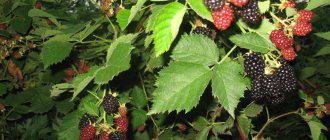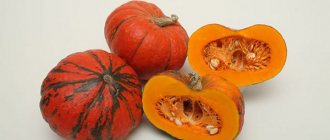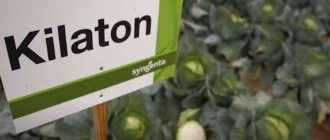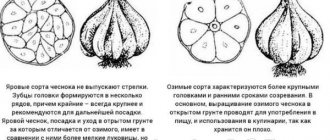Why replant blackberries to a new place?
Wild blackberries can grow in one place for up to 30 years. After 10 years, a cultivated plant must be transplanted to another place. The process consists of carefully digging up the bush, trimming all branches, and carrying the root system with a lump of earth. The plant is planted in a new hole so that the root collar remains at the same level.
The main purpose of replanting is to renew the bush. You can propagate your favorite variety using the division method. Replanting may be necessary simply in case of redevelopment of the yard or if it is necessary to divide a huge overgrown bush.
Choosing the right seedling
It is advisable to purchase planting material in special nurseries, where various forms of garden and remontant blackberries are presented.
The remontant variety receives more positive reviews - its fruiting is more extended, and its resistance to climatic conditions and diseases is much higher.
As for the level of branch formation, from this point of view it is better to give preference to annual specimens with several shoots, the diameter of which is more than 0.5 cm.
Also pay attention to the rhizome - it should look healthy, without signs of rotting. An eye should already be formed on it. An hour before rooting, the roots can be kept in a solution of 1 liter of water and 1 teaspoon of 3% hydrogen peroxide.
When is it better to replant blackberries: in spring or autumn?
Blackberries are replanted in spring and autumn. However, each season has its own advantages and disadvantages. The optimal timing of transplantation is determined taking into account the climatic conditions of the region.
The advantages of transplanting in early spring are the guaranteed survival rate of the seedling. This option is more suitable for northern regions, since a plant transplanted in autumn does not have time to take root before frost. The disadvantage of spring transplantation is the difficulty of accurately determining the timing. It is necessary to catch that short period during which the process of sap flow has not yet begun, and the earth has already thawed after the winter.
Important! During the spring transplantation of blackberries, you should not oversaturate the hole with fertilizers. The root system that has not taken root is severely damaged.
A positive feature of autumn transplantation is the rooting of the seedling. In early spring the plant grows quickly. However, blackberries need to be replanted two months before the expected date of frost. For the winter, the seedling is well insulated. For the northern regions, the autumn method of transplantation is not available, and this is a big drawback. The advantages of the method are fully appreciated by residents of the south.
Video: features of autumn planting blackberries
Breeders have developed many varieties of winter-hardy and even thornless blackberries, so you should not be afraid to plant this crop in your summer cottages. If you follow the rules of agricultural technology and appropriate care, you will be able to enjoy the taste of these wonderful berries even in the northern regions.
- Author: Svetlana Lukyanova
I write with pleasure and about many things. Rate this article:
- 5
- 4
- 3
- 2
- 1
(4 votes, average: 5 out of 5)
Share with your friends!
When can you replant blackberries to another place?
The specific timing of transplantation in the spring is determined by weather conditions. Usually falls in April. In May, blackberries can no longer be touched. The plant begins the active phase of sap flow.
The time for autumn transplantation falls at the end of September - beginning of October, provided there are no early frosts in the region.
Attention! A seedling transplanted in the fall, even of a frost-resistant variety, is covered for the winter.
Mistakes during autumn transplantation
Try to avoid typical mistakes that can occur when transplanting blackberry bushes in the fall:
There are no special precautions for planting blackberries in the autumn. On the contrary, transplanting this season has many advantages.
Follow the above recommendations, and blackberry bushes will delight you with an attractive appearance and provide you with the opportunity to enjoy the aromatic and valuable berries.
Source
Set of preparatory measures
The transplantation process is conventionally divided into two stages: preparatory and main work. The actions are the same for thorny and thornless varieties of blackberries.
Selecting a suitable site
The site for transplantation is selected according to similar rules observed when planting a young seedling. For the plant, choose a sunny place, protected from northern winds. It is advisable to choose a hill, but make a depression for the seedling itself. On a mound, the blackberries will not be flooded by rain and melt water, and the hole under the plant will better retain water during watering.
The site is selected with loamy or sandy loam soil. You can replant the crop into a garden bed where any garden crops grew last season, except for nightshades and berries.
Soil preparation
In order for the transplanted bush to take root, you need to carefully prepare the soil:
- carry out a soil acidity test and, if necessary, bring it to neutral levels;
- the site is dug up to a depth of 50 cm;
- roots of weeds are selected from the ground;
- spread a 10 cm layer of compost and a 3 cm layer of any crushed organic matter evenly over the bed: leaves, sawdust;
- Calcium, phosphorus, and magnesium are added from mineral fertilizers;
- all layers are dug up again along with the soil;
- the bed is generously filled with water, covered with an 8 cm layer of mulch to speed up the process of overheating of organic matter;
- A trellis is installed at the site where the seedling is supposed to be planted.
When preparing the soil for replanting blackberries, the acidity is increased by adding iron sulfate at the rate of 500 g/10 m2. You can add 300 g of sulfur to a similar area, but the process will go slower. To reduce acidity, lime is added.
Preparation of planting material
To transplant blackberries to another place, you first need to dig them up. They try to dig a mature bush as deeply as possible with a shovel from all sides. The plant is removed from the soil so that a lump of earth remains. In this state, the blackberries are transferred to another place.
The preparation of an adult bush begins with pruning the above-ground part. You cannot leave stumps from old branches, as pests will infest them and the plant will disappear.
If a large bush is transplanted, it is propagated by division. The process consists of the following steps:
- the plant to be transplanted is dug up from all sides, removed from the ground, and the lump of soil is carefully kneaded to free the roots;
- the bush is divided with a sharp knife so that each cut off seedling has 2-3 branches and 1 underground bud on the roots;
- The divided planting material is planted in prepared holes.
Dividing the bush during transplantation can be done in the spring immediately after the snow melts or in the fall 2 months before the onset of frost.
Attention! An old blackberry bush cannot be divided. The plant is replanted only as a whole.
Optimal timing for transplantation
Regardless of the region, soil type and climatic conditions, it is recommended to plan the blackberry replanting event in advance for the spring season. The beginning of the growing season is the most successful.
There is no active sap flow; the bush has not yet fully woken up, which means it will experience less stress.
Autumn work can be carried out exclusively in the southern regions. Here winters are not characterized by frost or an abundance of snow.
Both factors will negatively affect the bush. Therefore, in the fall the procedure is not carried out in the central and northern parts of the country.
It is possible that the bush will need to be moved in the summer. There are good reasons for this, but it is impossible to guarantee effective adaptation of blackberries in a new place.
Spring
When asked whether or not it is possible to replant blackberries in the spring, all gardeners without exception will answer positively.
This is especially true for thornless varieties. It is recommended to always plant them and move them only in the spring.
The spring procedure has positive and negative aspects. Let's look at them in more detail:
Advantages and disadvantages
The plant has not yet fully woken up - it will experience less stress
The weather is positive and stable
At the same time, you can carry out sanitary pruning
There is time for a procedure that needs to be carried out slowly
There is a risk of night frosts
You may not have time to transfer the bush due to swollen buds
High humidity provokes the development of fungal diseases. Spores can settle on cuts, which will lead to drying out of the blackberry
Work takes place early in the morning. The weather should be dry and windless. The planting pit is prepared at least 14-21 days before transplanting.
It is difficult to say in which month it is better to carry out the manipulations. Depends on:
- winter of the current year;
- climatic conditions;
- amount of precipitation in winter.
For the southern lands, the estimated dates are March-April. For the northern part, it is recommended to transplant blackberries in May.
The bush itself will tell you the exact time for work: before the buds swell, which indicates passive sap flow or its complete absence.
Need to know! In the process of preparing the planting hole, 1/3 of it is covered with a nutritious soil mixture. The main thing for a gardener is not to overdo it with fertilizers. The bush is not a seedling; it received regular feeding. Therefore, the soil mixture should be prepared taking into account previous fertilizing.
Summer
There is only one problem that will force the farmer to transplant blackberries to a new place - the bush has become sick due to an excess of fertilizers and watering.
It is not a fact that the procedure will be successful in order to save the plant. But it's worth the risk.
Manipulation is prohibited during flowering. If problems arise during the fruiting period, there is no time to wait, the gardener should say goodbye to the harvest.
The blackberry bush is completely exposed, leaving part of the main shoot. The transfer efficiency is 25%, while the autumn and spring procedures give 85-90% each.
Autumn
The time of year is favorable in all respects if the work is planned in the southern territories. Winters are warm, without sub-zero temperatures.
The shrub is prepared for the event throughout the summer: fertilizing is applied, branches are pruned.
The planting site is prepared in the spring, the soil is allowed to rest and gain strength.
The positive point is that the work will begin after fruiting, the activity of the movement of juices decreases, and the plant gradually enters the sleep stage.
There are no exact dates, but there is a hint: start transplanting at least 2 months before the expected low temperature.
When do you usually replant blackberries?
in spring
46.43%
in autumn
53.57%
Voted: 28
Transplanting blackberries to a new place in the spring
When transplanting, the mother bush can be propagated not only by division, but also by root shoots. The latter method involves planting seedlings from young shoots. Regardless of the method of reproduction, transplantation is carried out in the following order:
- Before transplanting, plan the location of the plants in the garden bed. Blackberries are planted in rows. Between seedlings of upright varieties, a space of up to 2 m is left. For creeping crops, the distance is increased to 3 m. The row spacing also depends on the type of bush and ranges from 1.8 to 3 m.
- If young shoots are used for transplantation, then a hole is dug 50 cm deep, with a diameter the size of the root. For an old bush, a hole is dug according to the dimensions of the root system. It is better to transplant blackberries into trenches 50 cm deep, dug along the length of the bed.
- During plant replanting, 1 bucket of compost and 100 g of mineral complex fertilizers are added to each hole, but it is better to get by with organic matter alone.
- The bush to be transplanted is dug up from all sides. In an adult plant, the root goes deep into the ground. It will not be possible to remove it. The rhizome is simply cut off with a shovel bayonet.
- The blackberries are carefully transferred, immersed in a new hole, and covered with earth.
After transplantation, the plant is watered abundantly, maintaining moisture until complete engraftment. After watering, the tree trunk soil is covered with mulch.
Selection and preparation of a site for blackberries
Blackberries are in dire need of sun and warmth. For it, you need to select the sunniest area, which is protected from cold gusty winds from all sides . This berry bush feels very poorly and does not take root well in dry places; it requires constant light moisture. But excess moisture, swampiness and close groundwater levels (above 1.5 m) are destructive for the crop.
For blackberries, choose a well-lit place
Blackberry bushes grow best on moisture-intensive, fertile, rather heavy clay and loamy soils. Even on hot summer days, the soil should hold water well and not dry out. It will not be possible to obtain a good harvest on sandy and rocky soils that do not retain moisture well.
Heavy clay carbonate soils rich in magnesium and calcium salts are not suitable for blackberries.
The area for blackberries needs to be dug up well
About 2–3 weeks before planting, the area intended for blackberries must be weeded and dug to a depth of at least 0.45–0.5 m, simultaneously selecting the roots of perennial weeds. Then planting holes are prepared with a diameter of about 0.5–0.55 m and a depth of up to 0.5 m. The extracted fertile soil is mixed with:
- humus or rotted compost - 9–10 kg;
- superphosphate - 45–50 g;
- potassium sulfate - 25–50 g;
- wood ash - 100–150 g.
The resulting soil mixture fills the hole to 2/3 of its volume.
The planting pit is filled with mineral and organic fertilizers
You can add any autumn phosphorus-potassium mineral complexes with a minimum nitrogen content.
Photo gallery: autumn fertilizers for blackberries
When applied in the fall, Autumn fertilizer replenishes the lack of potassium in the soil and prepares plants for winter
Phosphorus-potassium fertilizer Your garden bed is a complex, highly effective chlorine-free fertilizer containing phosphorus and potassium
Agrochemical "Gera Autumn" - mixed fertilizer for the main application for autumn digging and during autumn planting of strawberry seedlings, fruit and berry and coniferous trees and shrubs, bulbous crops
Autumn fertilizing with a potassium mixture will help berry bushes survive frosts and prepare them for fruiting next year.
Complex specialized mineral fertilizer Autumn contains an increased amount of phosphorus and potassium, which are especially necessary for plants in the autumn.
Organomineral fertilizer Autumn is used for application to vegetable, garden and ornamental crops on any soil.
Autumn fertilizer is used to feed plants at the end of the growing season (August-October)
Phosphorus-potassium mixture does not contain nitrogen
Superphosphate is a fertilizer that has a long-term effect on crops
Video: preparing a plot for blackberries
Transplanting blackberries to a new place in the fall
Autumn replanting begins after fruiting has ended. There should be about two months left before the onset of frost. During this time, the transplanted plant will have time to take root. The process of autumn and spring transplantation is identical. The only difference is the protection of the seedling from frost. After the autumn replanting, the tree trunk soil is covered with a thick layer of mulch. Additionally, before the onset of winter, they organize a reliable shelter made of spruce branches or non-woven material.
You can replant in the fall not the entire bush, but young shoots from the roots. They are called offspring. Young shoots are the best option for preserving and propagating the variety, as it eliminates the complex process of replanting an old bush.
Many varieties of creeping blackberries do not produce offspring. In order not to replant the old bush, the crop is propagated by layering. In August, the blackberry vine is bent to the ground and covered with soil, leaving the top. After a month, the cuttings will take root. The resulting seedling is separated from the bush in September and transplanted to another place.
Benefits of spring transplantation
There are a number of serious advantages to moving to the spring. First of all, in the spring it is more convenient for the gardener to observe the reaction - how the shrub is accepted, whether the selected site is suitable. It is easier to notice problems and help the seedling in time. In addition, the spring-summer season is the time for standard planting care: watering, fertilizing, hilling. The above actions gently stimulate and accelerate the rooting of blackberries.
Warm weather promotes strong, healthy rooting - in the spring the soil is moist and loose. The main thing is that the seedlings manage to take root firmly before the onset of cold weather, which is very important for older, weakened shrubs. The soil, damp after melting snow, is excellent for young shoots. Finally, in the spring, they receive suitable material for transfer - young root shoots are more resilient than adult plants and tolerate stress more calmly.
Is it possible to replant blackberries in summer?
Theoretically, summer replanting of blackberries can be done, but there is no guarantee of 100% survival of the plant. For testing, it is better to choose a variety that you don’t mind. To ensure a successful summer transplant, adhere to the following rules:
- transfers are carried out early in the morning or late in the evening;
- all work is completed as quickly as possible;
- immediately after transplanting, a shading structure is installed over the blackberries;
- Water the transplanted plant abundantly every day.
In summer, heat is detrimental to a dug-out plant. If blackberries are not immediately planted in a permanent place, they will quickly wither.
Caring for blackberries after transplantation
Caring for a transplanted plant is no different, as for other blackberry bushes. Initially, abundant watering is needed. You can’t rush with feeding. Mineral fertilizers can burn the root system that has not taken root. Over time, after adaptation to a new place, you can begin to add organic matter.
Caring for transplanted blackberries requires standard actions:
- In autumn and spring, pruning and shaping of bushes is carried out. Blackberry vines are tied to a trellis. For the winter, the stems are bent to the ground and covered with spruce branches or other insulation.
- In summer, blackberries are sometimes attacked by the gall mite. You can fight the pest with chemicals or garlic infusion.
- After the heat has subsided on warm evenings, the blackberries are irrigated with cool water. Sprinkling hardens young stems.
- The next spring after transplanting, the blackberries are fed with potassium during the appearance of buds.
The transplanted plant initially requires proper care for rapid rooting.
More details about transplanting blackberries are shown in the video:
Common mistakes and methods for solving them
Newbie gardeners tend to make mistakes. This is natural and not condemned. Of the most common, three are identified:
- Application of complex fertilizers during the first season after transplanting blackberries. This can be corrected by increasing watering and drying excess moisture by applying paper.
- Blindly following recommendations. You should always make allowances for weather conditions and soil conditions. In case of drought, the amount of watering is increased, and in case of frequent rains, it is reduced. To prevent waterlogging, check the soil moisture below the mulch level.
- Creating a shelter for a seedling is a prerequisite for wintering. The root system is young and sub-zero temperatures will damage it. Despite the winter hardiness of the blackberry variety, the root system is not ideal. You cannot count on this characteristic of the species.











